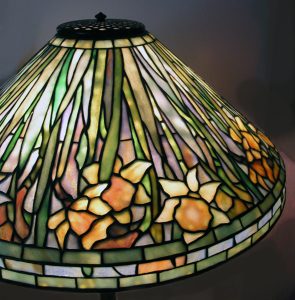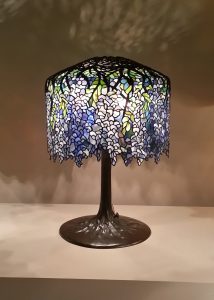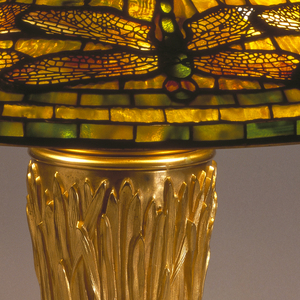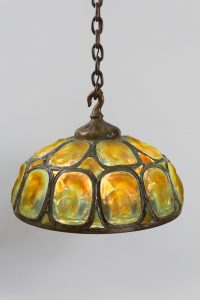
Spring bulbs in bloom, branches heavy with apple blossom, trailing racemes of laburnum and wisteria, each illuminated in stunning clarity, as vivdly as in nature. The bright botanicals of Tiffany lamps are a phenomenon of design, but the little-known history behind their creation is equally astonishing.
While Louis Comfort Tiffany was always the marquee name at the forefront of Tiffany Studios (and a carefully maintained brand image), much of Tiffany’s creative work was carried out in anonymity by a large team of designers and artisans. Although the Tiffany staff was largely male, women soon became a key part of the workforce. From 1892 onwards, a critical part of of the cohort comprised a creative powerhouse of women: the self-annointed ‘Tiffany Girls’. They worked in the Women’s Glass Cutting Department, a separate division within the otherwise male design team. The department was led by a remarkable woman whose artistic talents played an enormous but publicly underrepresented role in the company’s prodigious output.

Clara Driscoll, a skilled designer and artist in glass, created many of the company’s most beautiful and innovative designs, including iconic dragonfly and wisteria lamps, striking peony and poppy lamps and various other floral filigree lamp designs illustrated here. In fact, according to recent research detailing the history of Driscoll’s influence and the work of the women designers: “It was possibly Clara who hit upon the idea of making leaded shades with nature-based themes,” A major element of the Tiffany brand.

Clara counted many skilled and artistically adventurous women among her team, including Agnes Northrop, another talented and prolific designer, but the demands of the work meant that it was not a job for any artist, regardless of her abilities. As inconceivable as it may seem in our times, women could only be employed at the Studios if they were single. Clara was obliged on two separate occasions to leave her job, the first of which when she was engaged to be married. She returned to work after the untimely death of her husband, but left again when she became engaged for a second time. This engagement ended in the mysterious disappearance of her fiancé and Clara’s ensuing third term at Tiffany was her longest and most prolific. During this time she was also responsible for managing the now sizeable department of some 35 women.
Continue reading “Fresh light on spring blooms: Clara Driscoll and the ‘Tiffany Girls’”




